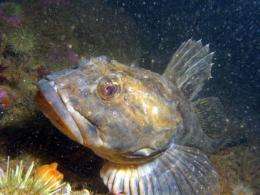Neutron science explains mystery of how Arctic fish's antifreeze proteins work

Neutron scientists have discovered for the first time how 'antifreeze' in arctic fish blood kicks in to keep them alive in subzero conditions. The results could provide benefits for areas as diverse as cryosurgery, food processing and agriculture.
Biological antifreeze proteins (AFPs) are unusual proteins in several ways. They safeguard organisms from freezing to death by binding to ice crystal nuclei as soon as they start to form in bodily fluids, and prevent them from growing into ice crystals. However, AFPs must not attach to liquid water otherwise the organism would dehydrate and die. New research using neutrons provides the first experimental data showing how type-III AFPs, found in arctic fish blood, recognise the ice crystal nuclei. It found that unusual hydrophobic regions on the protein surface fit into ‘holes’ in the ice crystal nuclei structure.
“AFPs are unusual proteins with a difficult job. We wanted to understand how they can work in an aqueous environment like blood but only interact with H2O molecules when they start to freeze. Neutron scattering provided essential information about how this happens. We found that the key is how the AFPs’ structure differs from typical proteins, and how the structure of ice compares with liquid water,” says Matthew Blakeley, an instrument scientist at ILL.
Biological proteins usually have hydrophobic amino acids in the core (away from water molecules in the solvent) and hydrophilic amino acids on the surface. Unusually, AFPs have many hydrophobic amino acids on their surface. These form part of the special binding surface that only sticks to ice nuclei, ie to solid but not liquid H2O. There have been a number of theories about how this works, but up till now no experimental observation of the molecular mechanism because hydrogen is almost ‘invisible’ to most imaging techniques.
“Neutrons ‘see’ hydrogen very well, so neutron scattering was the only way that we were able to locate the positions of H2O molecules at the protein’s binding surface. We identified an 'ice-type' tetrahedral cluster of waters at the binding surface. These mimic the arrangement of water molecules in ice, so we used these positions as the starting point to build up the rest of the ice crystal and model the ice-AFP interaction,” says Alberto Podjarny, from IGBMC in Strasbourg, who led the neutron research.
“The ice model has six rings of four H2O molecules, which leaves a gap, or hole, in the middle. The hydrophobic regions of the type-III AFPs fit into these holes and bind with the ice’s surface. These ‘holes’ are what distinguish the structure of ice crystal nuclei from water, and explain how AFPs can be present in a solvent without attaching to the water molecules until they start to freeze,” says Eduardo Howard from the Instituto de Física de Líquidos y Sistemas Biológicos (IFLYSIB) in Argentina. “This understanding has exciting implications for biomedical applications such as cryosurgery and tissue preservation.”
There are varied commercial applications for antifreeze proteins. These include:
• Medicine – improving cryosurgery; enhancing preservation of tissues for transplant or transfusion
• Food processing/production – lengthening the shelf life of frozen foods
Unilever are using AFPs to improve the consistency and storage properties of ice cream
• Agri/Aquaculture – increasing freeze tolerance of crop plants; improving farm fish production; extending the harvest season in cooler climates
Now the mechanism of recognition is understood, the next step is to investigate how AFP prevents the ice crystal nuclei growing into ice crystals.
More information: Journal of Molecular Recognition, 7 April 2011.
Provided by Institut Laue-Langevin



















